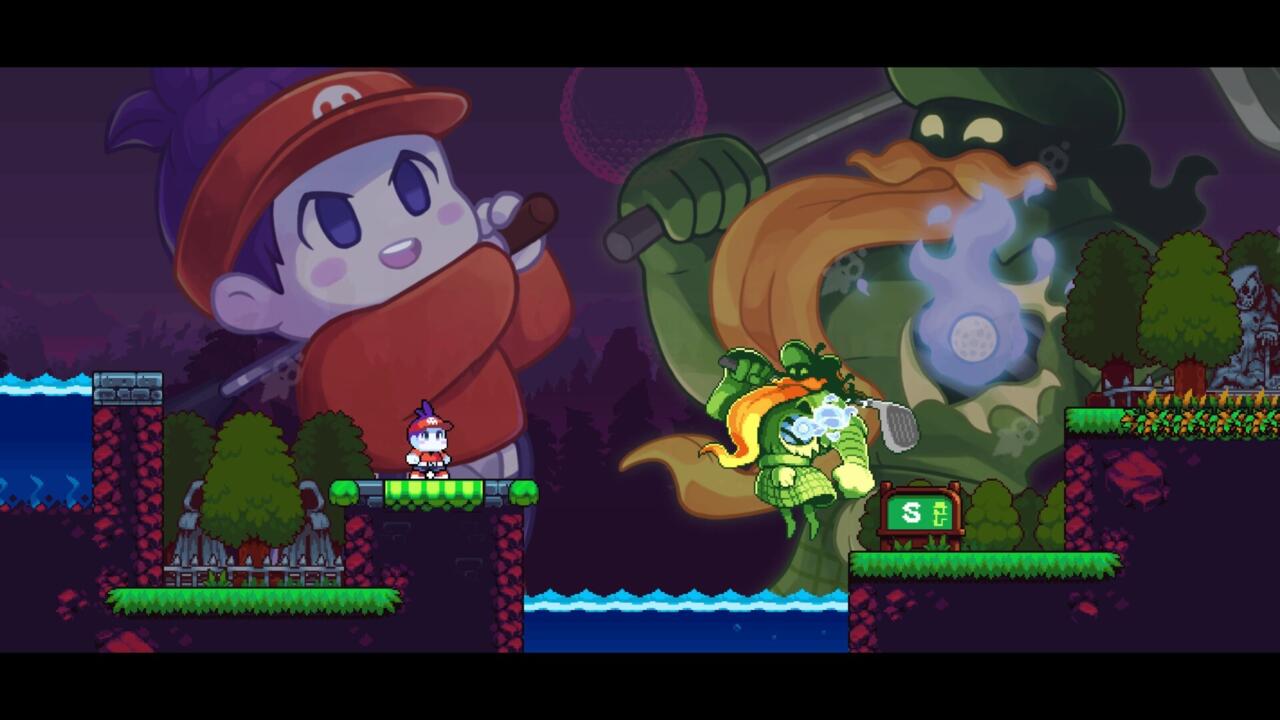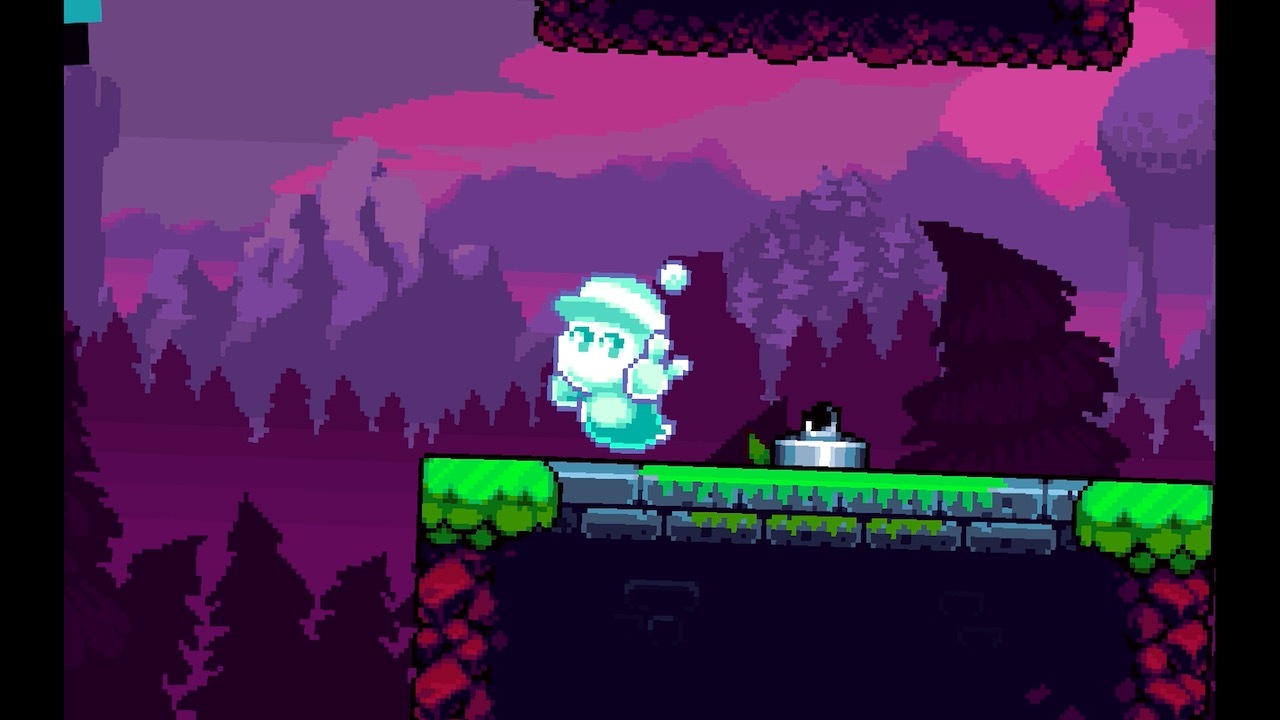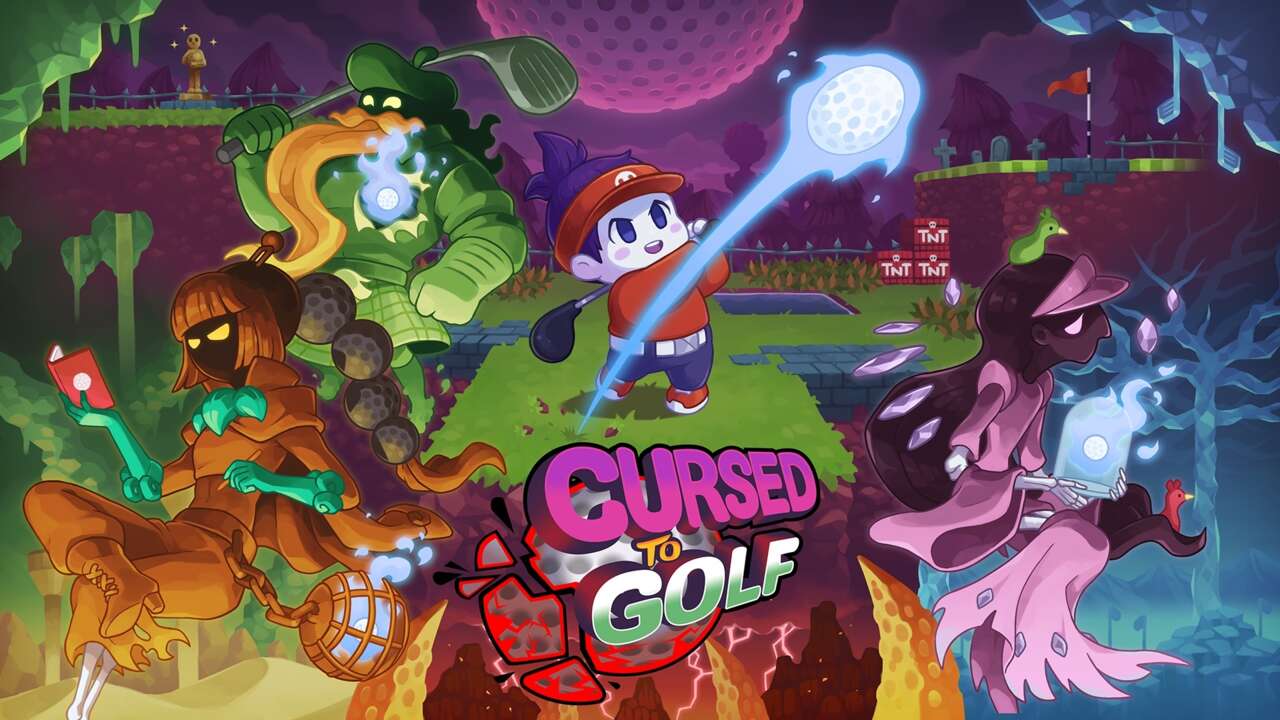I’m standing on the tee of a familiar hole. A booming drive will fly over ponds, bunkers, and spikes before colliding with a golden idol to add four shots to par. But now that I have a variety of Ace Cards, I can follow a wildly different path. There’s a column of TNT directly behind me that I blow up with a card before equipping another one that lets me change the direction of the shot in mid-air. I take out my wedge and pitch the ball into the newly created opening behind me. Before it drops into the water below, I redirect the ball through a narrow passage and into a small nook filled with spikes and a handy ricochet bumper. Then, I fling it backwards at the bumper, which allows me to redirect the ball for a third time. The ball soars through the small opening, bounces twice on the island green, and falls into the cup with the help of a bit of spin I added. A hole-in-one–my first in Cursed to Golf. The first two times I played this hole, it took me around five minutes and more than a dozen shots.
The magic of Cursed to Golf comes from the moments when you figure out entirely new ways to finish levels more efficiently and in mechanically interesting ways. Even though Cursed to Golf allows you to send your golf ball through portals, turn it into ice and thunder, or even transform it into a rocket, it captures the beauty of actual golf in a way that very few golf games have in the past–even “realistic” ones. Like real golf, each and every shot feels different, and, most importantly, the only limitation you have is your creativity and ingenuity. The freedom you’re given to experiment throughout each level makes subsequent runs through the very same layout feel entirely fresh.
During the final round of a tournament, you’re killed by a lightning strike and sent to Golf Purgatory, an underworld with a diabolical golf course operated by the Greenskeeper. To escape, you have to finish all of the 18 side-scrolling holes in a row without running out of shots. A roguelike structure sends you back to the beginning of the course if you fail during any of the levels. Gameplay is the focus here, but Cursed to Golf has witty dialogue, a rather heartwarming story, and a lighthearted tone despite the fact you’re essentially trapped in hell.
On the surface, Cursed to Golf has simplistic gameplay mechanics. It uses a click-based swing system. You set your power using a meter and your aim by pressing the button again. Critically, aiming isn’t manual. The direction of your shot corresponds to your click timing. A shot preview shows you the path the ball will take, so you always know where it’s headed. Your bag consists of a driver, iron, and wedge.
On a shot by shot basis, Cursed to Golf is a lot of fun, even when you’re not using Ace Cards, the power-ups and perks you collect throughout each run that can modify shots. Rapidly pressing a button in the air and then pointing the D-pad or stick in the desired direction creates spin on the ball when it lands. Due to the sheer chaos of the levels, spin is monumentally important. The ball physics are stellar. In some ways, Cursed to Golf resembles precision platformers thanks to its tight controls that provide depth and reward mastery.

Ace Cards turn levels into clever puzzles to be cracked. Cursed to Golf has more than 20 different Ace Cards. Some of the cards provide basic perks, such as taking a mulligan (repeating the previous shot), adding strokes to your par count, or taking a practice shot. Most of them, however, affect the golf ball and its flight.
You can turn the golf ball into a drill to dig through walls, coat it with ice to freeze ponds, electrify it to destroy vines that otherwise eat the ball and give you a one-stroke penalty, and redirect the shot with the U-Turn card to get a hole-in-one (hopefully). Multiple different rocketballs give you free control over your shot in the air, some of which go faster and farther and others that are better at cutting corners. Scattershot lets you press a button in mid-air to break the ball into three, and lets you pick which one to play afterward. You can stop the ball in mid-air so it drops immediately, as well as make it act like a lead weight to stop it from rolling when it touches down. One Ace Card turns the ball into a matterless object, so it can pass through walls and other obstacles. Meanwhile, you can set up portals, which yes, work just about the same as they do in that Portal.
The sheer variety of Ace Cards give you many, many different ways to approach each shot, and make some of the game’s more daunting levels more approachable. I found myself experimenting with different cards on a regular basis, learning new methods for lowering my scores even after putting more than 20 hours into the game. You start each run with a small assortment of Ace Cards, but as you progress through the increasingly challenging levels, your deck expands and so do the possibilities.
In Cursed to Golf, your main currency is cash, which is earned based on how many remaining shots you have left at the end of each level. You can then spend cash on Ace Card packs and single cards in the shops you come across throughout each run. You can also find money and Ace Cards in chests while driving your cart between holes in the overworld. The setup is similar to other roguelikes such as Slay the Spire, with forks in the road that give you a choice of which direction to take.
Cursed to Golf’s level design reminded me a lot of Spelunky in that it has verticality to it as well as many small ledges and sections throughout each level that feel like little self-contained challenges. Split up into four biomes–grassy, desert, cavern, and fiery hell–the 18-hole course throws a dizzying barrage of obstacles and designs at you. While it is a roguelike, the sprawling levels are not randomly generated. The Greenskeeper “shifts” the course around, putting levels in different spots, and introducing levels you haven’t played during your next run. Chuhai Labs says there are more than 70 possible levels. In the 12 runs it took me to beat all 18 levels, I probably saw around 40-50 different course layouts.

Even though there isn’t an “endless” supply of levels, each level has numerous paths to take. Some of the later levels are so large that you’d probably have to play them at least 10 times to see every area. Many levels also have multiple flagsticks, so you can beat it by reaching either one. Each of the biomes introduces new obstacles. The grassy zone mostly has spikes, water, and bunkers to stand in your way. The desert biome adds giant mounds of sand, more elaborate spikes, the aforementioned bumpers to essentially play pinball, moving platforms, and tunnel systems to transport your ball. The cavern levels trade the huge bunkers for those vines that eat your golf ball. All of these biomes have teleporters and in hard-to-reach spots that can help you skip part of the level, and there are wind turbines that can guide your ball through labyrinthine corridors.
Cursed to Golf balances risk and reward extremely well with its varied level design. The hazards are deftly placed to make you really stop and think about which Ace Card to use and which route to take. Seeing as many hazards also inflict a one-stroke penalty, avoidance is important. You only start each hole with five total shots, but you can add to that count by breaking idols throughout each hole and using Ace Cards. The “risk” is always due to the difficulty of the shot you’re attempting; even when using wacky Ace Cards, you’re not leaving the end result to chance. A well-executed shot always works, which makes Cursed to Golf rigorously fair, despite its silliness.
The first time I played one of the cavern levels, it took me more than 30 shots due to playing it safe and taking the clearest route. The next time I played that hole, I beat it in five shots thanks to Ace Cards and an appetite for risk. It’s an impressive feat in level design that both of those outcomes felt rewarding in their own ways. Late-game levels have such tricky structures that you could reasonably use an Ace Card on every shot and it wouldn’t feel like a waste.
The risk-reward extends to your choice of which path to take. There are “Cursed” versions of levels that are tougher but reward you with a pack of Ace Cards and are often located on a path alongside treasure chests and shops. Cursed levels inflict you or the course with a detrimental quirk every few shots. Idols are removed from the course, your deck is locked, turbulent wind/rain is present, your driver isn’t playable, etc. There’s even a pesky curse that flips the screen upside and another that only lets you hit the ball right or left. Cursed levels also have mucky little gravesites that penalize you one shot. The risk of dying on a Cursed course is certainly higher than regular layouts, but the rewards are incredibly useful for the long haul. This is where you’re rewarded for smart use of Ace Cards and precise shots.
It’s not just the Cursed levels that make the roguelike progression system really hum. I love how Cursed to Golf implements roguelike features in an encouraging way. At first, you may only make it through a few holes before dying, but once you start to understand the rules, the levels become daunting but doable. You lose all of the Ace Cards you earned during the run and your cash when you die. Considering that later levels often demand the use of Ace Cards, Cursed to Golf would likely be a pretty frustrating experience if it didn’t implement a few progression system features after defeating bosses.
Throughout your run, you face off against a trio of bosses, each of which you have to beat to the flag in order to move on. All three of the bosses have their own unique quirks and personalities that make them interesting and fun to play against. The large armor-clad Scotsman hits ridiculously long drives. The Explorer changes sections of the course throughout the hole to try to trip you up. And The Forgotten gets the assistance of a couple of birds–Birdie and Albatross (golf names!)–who cheat and carry the ball through tough areas of the level. Once you beat a boss, you don’t have to face them again in subsequent runs. This compelled me to go all out with my Ace Cards to win–even if it meant not having many left for the ensuing levels.

Your rewards for conquering these formidable foes are immense and make Cursed to Golf one of least stressful–yet still challenging–roguelikes I’ve played. The first ability you get is a checkpoint flag, which lets you save your progress after a completed hole once per round. If you die, you’ll still lose your gear, but you won’t have to start at the beginning (unless you die again). The Gimmie ability raises your par count back to five after your final stroke one time per hole, effectively giving you 10 shots by default. The final, and ultimately most useful, perk allows you to return to the checkpoint flag (or beginning) with all of your Ace Cards after death once per round. These abilities combined with storing some of your cards in a binder to grab during future runs go a long way toward letting you experience the totality of the game in a way that highlights all of its best features–Ace Cards, all four unique biomes, and the many different levels.
My first completed run took 2.5 hours–the game saves after each level and logs your stats for each run–and I spent 15 hours total to get there. During my second completed run, I aimed for the lowest score possible, and I found a pretty fun way to do it. I played through the first 15 holes while only using a couple of Ace Cards. Then I purposely died to go back to the beginning with all my cards. I was able to use cards on almost every shot and never ran out. I even finished that run with more than 100 cards left. So if you’re worried about Cursed to Golf’s difficulty or you’re averse to roguelikes, you can game the system without too much stress.
Cursed to Golf is an absolute joy to play, but it’s also lovely to look at and listen to. The colorful character sprites and environmental designs have a Game Boy Advance vibe to them that’s utterly charming. The electronic soundtrack, composed by Mark Sparling (A Short Hike), is upbeat, catchy, and complements the visuals to make a welcoming atmosphere you want to spend time in.
Every aspect of Cursed to Golf comes together to form a truly special and unique game. With its simple hook, brilliantly designed levels, huge suite of dynamic abilities, and a finely balanced roguelike structure, Cursed to Golf is a constant delight. There have been many great games released in 2022 so far, but Cursed to Golf is easily at the top of my list at this moment. It’s one of the best golf games ever made, but you don’t have to like golf to enjoy the curse of being forced to play it.
















